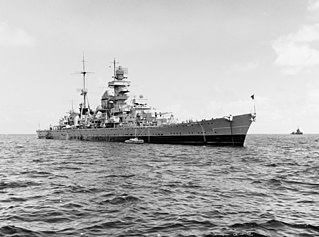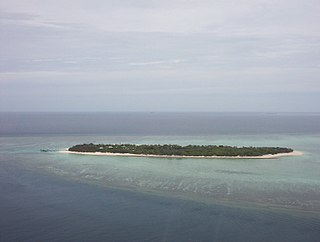
Prinz Eugen was an Admiral Hipper-class heavy cruiser, the third of a class of five vessels. She served with Nazi Germany's Kriegsmarine during World War II. The ship was laid down in April 1936, launched in August 1938, and entered service after the outbreak of war, in August 1940. She was named after Prince Eugene of Savoy, an 18th-century Austrian general. She was armed with a main battery of eight 20.3 cm (8.0 in) guns and, although nominally under the 10,000-long-ton (10,000 t) limit set by the Anglo-German Naval Agreement, actually displaced over 16,000 long tons (16,000 t).

Mudjimba is a coastal suburb in the Sunshine Coast Region, Queensland, Australia, and forms part of the Maroochydore urban centre. In the 2016 census Mudjimba had a population of 2,540 people.

MV Neptuna was a 5,952 ton cargo motor vessel. She was launched as MV Rio Panuco in 1924, renamed MV Neptun in 1931 and finally became MV Neptuna in 1935. She was sunk during the Japanese air raid on Darwin on 19 February 1942, during World War II.

SMS Kronprinz was the last battleship of the four-ship König class of the German Imperial Navy. The battleship was laid down in November 1911 and launched on 21 February 1914. She was formally commissioned into the Imperial Navy on 8 November 1914, just over 4 months after the start of World War I. The name Kronprinz refers to Crown Prince Wilhelm, and in June 1918, the ship was renamed Kronprinz Wilhelm in his honor. The battleship was armed with ten 30.5-centimeter (12.0 in) guns in five twin turrets and could steam at a top speed of 21 knots.

HMAS Warrnambool (J202), named for the city of Warrnambool, Victoria was one of 60 Bathurst-class corvettes constructed during World War II, and one of 36 initially manned and commissioned solely by the Royal Australian Navy (RAN). Warrnambool sank after she hit a mine in the Great Barrier Reef on 13 September 1947. She was one of only four Bathurst class corvettes lost while in Australian service, and the only one lost after World War II.

HMAS Diamantina (K377/F377/A266/GOR266), named after the Diamantina River in Queensland, is a River-class frigate that served the Royal Australian Navy (RAN). Constructed in the mid-1940s, Diamantina was active from 1945 until 1946, was placed in reserve, then was recommissioned as a survey ship from 1959 until 1980.

SS James Eagan Layne was a liberty ship. She was beached and sunk during the Second World War off Whitsand Bay, Cornwall, United Kingdom.
The Royal Adelaide was an iron sailing ship of 1400 tons built by William Patterson at Bristol in 1865.

The islands and reefs of the Capricorn and Bunker Group are situated astride the Tropic of Capricorn at the southern end of the Great Barrier Reef, approximately 80 kilometres east of Gladstone, which is situated on the central coast of the Gladstone Region, Queensland, Australia.
The blockade runner Mary Bowers, Captain Jesse DeHorsey, bound from Bermuda to Charleston, South Carolina with an assorted cargo, struck the submerged wreck of the SS Georgiana in fourteen feet of water a mile off of Long Island on August 31, 1864. She "went on with such force as to make immense openings in her bottom," and she sank in a "few minutes, most of the officers and men saving only what they stood in." The steamer's passengers and crew escaped with the exception of a boy, Richard Jackson, who was left on the wreck and later taken off by the Federals.

SMS Markgraf was the third battleship of the four-ship König class. She served in the Imperial German Navy during World War I. The battleship was laid down in November 1911 and launched on 4 June 1913. She was formally commissioned into the Imperial Navy on 1 October 1914, just over two months after the outbreak of war in Europe. Markgraf was armed with ten 30.5-centimeter (12.0 in) guns in five twin turrets and could steam at a top speed of 21 knots. Markgraf was named in honor of the royal family of Baden. The name Markgraf is a rank of German nobility and is equivalent to the English Margrave, or Marquess.

Yandra was a 990-ton coastal steamer built by Burmeister and Wain, Copenhagen in 1928 for Coast Steamships Ltd for service in the Australian state of South Australia. She was requisitioned by the Royal Australia Navy in June 1940 during the Second World War for conversion to a minesweeper and anti-submarine vessel and was commissioned on 22 September 1940 as HMAS Yandra. She returned to civilian service in 1946. She ran aground during dense fog onto South Neptune Island on 25 January 1959 and was subsequently written off.
Wollongbar was a 2,005-ton passenger steamship built by the Ailsa Shipbuilding Company, Troon in 1911 for the North Coast Steam Navigation Company.
HMAS Waree (W128) was a tug boat operated by the Royal Australian Navy (RAN) during World War II. She operated as a tug boat for the Waratah Tug and Salvage Company before being requisitioned by the RAN in 1942, and operating in northern Australia and Papua. She sank on 17 October 1946 off the New South Wales coast while sailing to Sydney from Thursday Island.
SS Francis Preston Blair was an American Liberty ship, 7,196 tons stranded on Saumarez Reef in the Coral Sea during a cyclone in 1945. The ship has since deteriorated into a rusty heap. The wreck was used by Royal Australian Air Force F-111 aircraft for target practice during the 1980s.

Espingole was a Durandal-class destroyer built for the French Navy in the late 1890s. Commissioned in 1900, she saw only a few years of service before running aground and sinking in 1903 off the Côte d'Azur. Her captain was acquitted at his court-martial seven years later. Multiple salvage attempts failed and a legal dispute arising from the last attempt was not settled until 1926.

Parbuckle salvage, or parbuckling, is the righting of a sunken vessel using rotational leverage. A common operation with smaller watercraft, parbuckling is also employed to right large vessels. In 1943, the USS Oklahoma was rotated nearly 180 degrees to upright after being sunk in the attack on Pearl Harbor, and the Italian cruise ship Costa Concordia was successfully parbuckled off the west coast of Italy in September 2013, the largest salvage operation of that kind to date.
SS Kielce was a Polish-operated cargo ship. She was a Type N3-S-A2 steamship, built in the USA in 1943 as SS Edgar Wakeman.

SS Marloo is a heritage-listed shipwreck at Great Sandy National Park, Fraser Island, Fraser Coast Region, Queensland, Australia. It was added to the Queensland Heritage Register on 12 October 2002 but delisted in 2015.
Oriana was a 295 GRT tug which was built in 1945 as Empire Frieda by Ferguson Brothers Ltd., Port Glasgow, Renfrewshire, United Kingdom for the Ministry of War Transport (MoWT). Ownership was transferred to the Ministry of Transport in 1946 and the Admiralty in 1947, when she was renamed Oriana. She struck a mine and sank in the River Colne, Essex on 19 January 1948 with the loss of all on deck.












